Structural Reliability Prediction Using Acoustic Emission-Based Modeling of Fatigue Crack Growth
Abstract
:1. Introduction
2. Experimental Approach
Noise Reduction
3. Analysis of Experimental Data and Results
3.1. Crack Growth Measurement
3.2. Test of Homogeneity
3.3. Probabilistic Model Development
3.3.1. Bayesian Data Analysis
3.3.2. Error and Uncertainty
- (a)
- Aleatory uncertainty: Also known as inherent uncertainty, aleatory uncertainty is a natural randomness of a quantity such as uncertainty in the material features. Generally, there are different factors during manufacturing of a material that cause random variation of the material properties from experiment to experiment [30]. To minimize aleatory uncertainty, test data of specimens from the same material lot (test samples coming from the same sheet of Al7075-T6 or Ti-6-4) were used. It should be noted that this physical variation is inherent to experiments and cannot be eliminated.
- (b)
- Epistemic uncertainties: This uncertainty is the result of limited information or incomplete information due to finite experimental data or a limited number of observed data points. The addition of experiments corresponding with each loading condition in the parameter estimation process can help reduce epistemic uncertainty bounds for the estimated model parameters. Two types of epistemic uncertainty are discussed below:
3.3.2.1. Model Error Estimation
3.4. Model Validation
4. Conclusions
Author Contributions
Conflicts of Interest
References
- Beattie, A.G. Acoustic emission, principles and instrumentation. J. Acoust. Emiss. 1983, 2, 95–128. [Google Scholar]
- Vanniamparambil, P.A.; Guclu, U.; Kontsos, A. Identification of crack initiation in aluminum alloys using acoustic emission. Exp. Mech. 2015, 55, 837–850. [Google Scholar] [CrossRef]
- Barile, C.; Casavola, C.; Pappalettera, G.; Pappalettere, C. Analysis of crack propagation in stainless steel by comparing acoustic emissions and infrared thermography data. Eng. Fail. Anal. 2016, 69, 35–42. [Google Scholar] [CrossRef]
- Kordatos, E.Z.; Aggelis, D.G.; Matikas, T.E. Monitoring mechanical damage in structural materials using complimentary NDE techniques based on thermography and acoustic emission. Compos. Part B Eng. 2012, 43, 2676–2686. [Google Scholar] [CrossRef]
- Barile, C.; Casavola, C.; Pappalettera, G.; Pappalettere, C. Acoustic sources from damage propagation in Ti grade 5. Measurement 2016, 91, 73–76. [Google Scholar] [CrossRef]
- Roberts, T.M.; Talebzadeh, M. Acoustic emission monitoring of fatigue crack propagation. J. Constr. Steel Res. 2003, 59, 695–712. [Google Scholar] [CrossRef]
- Biancolini, M.E.; Brutti, C.; Paparo, G.; Zanini, A. Fatigue cracks nucleation on steel, Acoustic emission and fractal analysis. Int. J. Fatigue 2006, 28, 1820–1825. [Google Scholar] [CrossRef]
- Rabiei, M.; Modarres, M.; Hoffman, P. Quantitative Methods for Structural Health Management using in-situ AE Monitoring. In Proceedings of the Annual Conference of the Prognostics and Health Management (PHM) Society, Montreal, QC, Canada, 25–29 September 2011. [Google Scholar]
- Bassim, M.N.; Hamel, F.; Bailon, J.P. Acoustic emission mechanism during high-cycle fatigue. Eng. Fract. Mech. 1981, 14, 853–860. [Google Scholar]
- Roberts, T.M.; Talebzadeh, M. Fatigue life prediction based on crack propagation and acoustic emission count rates. J. Constr. Steel Res. 2003, 59, 679–694. [Google Scholar] [CrossRef]
- Rabiei, M.; Modarres, M. Quantitative methods for structural health management using in situ acoustic emission monitoring. Int. J. Fatigue 2013, 49, 81–89. [Google Scholar] [CrossRef]
- Han, Z.; Luo, H.; Cao, J.; Wang, H. Acoustic emission during fatigue crack propagation in a micro-alloyed steel welds. Mater. Sci. Eng. A 2011, 528, 7751–7756. [Google Scholar] [CrossRef]
- Strantza, M.; Hemelrijck, D.; Guillaume, P.; Aggelis, D.G. Acoustic emission monitoring of crack propagation in additively manufactured and conventional titanium components. Mech. Res. Commun. 2017, 84, 8–13. [Google Scholar] [CrossRef]
- Gong, Z.; Nyborg, E.O.; Oommen, G. Acoustic emission monitoring of steel railroad bridges. Mater. Eval. 1992, 50, 883–887. [Google Scholar] [CrossRef]
- Bassim, M.N.; St. Lawrence, S.; Liu, C.D. Detection of the onset of fatigue crack growth in rail steels using acoustic emission. Eng. Fract. Mech. 1994, 47, 207–214. [Google Scholar] [CrossRef]
- Paris, P.; Erdogan, F. A critical analysis of crack propagation laws. J. Basic Eng. 1963, 85, 528–533. [Google Scholar] [CrossRef]
- Rabiei, M. A Bayesian Framework for Structural Health Management Using Acoustic Emission Monitoring and Periodic Inspections. Ph.D. Dissertation, Department of Mechanical Engineering, University of Maryland, College Park, MD, USA, 2011. Available online: https://search.proquest.com/docview/880410901?pq-origsite=gscholar (accessed on 15 July 2013).
- ASTM. Constant Load Amplitude Fatigue Crack Growth Rate above 10−8 m/cycle; American Society for Testing and Materials: Washington, DC, USA, 2008; pp. 321–339. [Google Scholar]
- Gauthier, M.M. Engineered Materials Handbook—Desk Edition; ASM International: Materials Park, OH, USA, 1995. [Google Scholar]
- Sauerbrunn, C.M.; Modarress, M. Effects of Material Variation on Acoustic Emissions-Based, Large-Crack Growth Model. In Proceedings of the 25th American Society of Nondestructive Testing (ASNT) Research Symposium, New Orleans, LA, USA, 11–14 April 2016. [Google Scholar]
- Morton, T.M.; Harrington, R.M.; Bjeletich, J.G. Acoustic Emission of fatigue crack growth. Eng. Fract. Mech. 1973, 5, 691–697. [Google Scholar] [CrossRef]
- Wang, Z.F.; Li, J.; Ke, W.; Zhu, Z. Characteristics of acoustic emission for A537 structural steel during fatigue crack propagation. Scr. Metall. Mater. 1992, 27, 641–646. [Google Scholar] [CrossRef]
- Keshtgar, A.; Modarres, M. Acoustic emission-based fatigue crack growth prediction. In Proceedings of the 2013 Reliability and Maintainability Symposium (RAMS), Orlando, FL, USA, 28–31 January 2013; pp. 1–5. [Google Scholar]
- Ferreria, T.; Rasband, W. ImageJ User Guide; U.S. National Institutes of Health: Bethesda, MD, USA, 2012.
- Keshtgar, A. Acoustic Emission-Based Structural Health Management and Prognostics Subject to Small Fatigue Cracks. Ph.D. Dissertation, University of Maryland, College Park, MD, USA, 2013. [Google Scholar]
- Miller, G.A.; Chapman, J.P. Misunderstanding analysis of covariance. J. Abnorm. Psychol. 2001, 110, 40–48. [Google Scholar] [CrossRef] [PubMed]
- Smith, F. Interpretation of adjusted treatment means and regression in analysis of covariance. Biometrics 1975, 13, 282–308. [Google Scholar] [CrossRef]
- Ntzoufras, I. Bayesian Modeling Using WinBUGS; John Wiley and Sons: Hoboken, NJ, USA, 2009. [Google Scholar]
- Bolstad, W.M. Introduction to Bayesian Statistics, 2nd ed.; John Wiley and Sons: Hoboken, NJ, USA, 2007. [Google Scholar]
- Ditlevsen, O.; Madsen, H.O. Structural Reliability Methods; John Wiley and Sons: Hoboken, NJ, USA, 2007. [Google Scholar]
- Ontiveros, V. An Integrated Methodology for Assessing Fire Simulation Code Uncertainty. Master’s Thesis, University of Maryland, College Park, MD, USA, 2010. [Google Scholar]
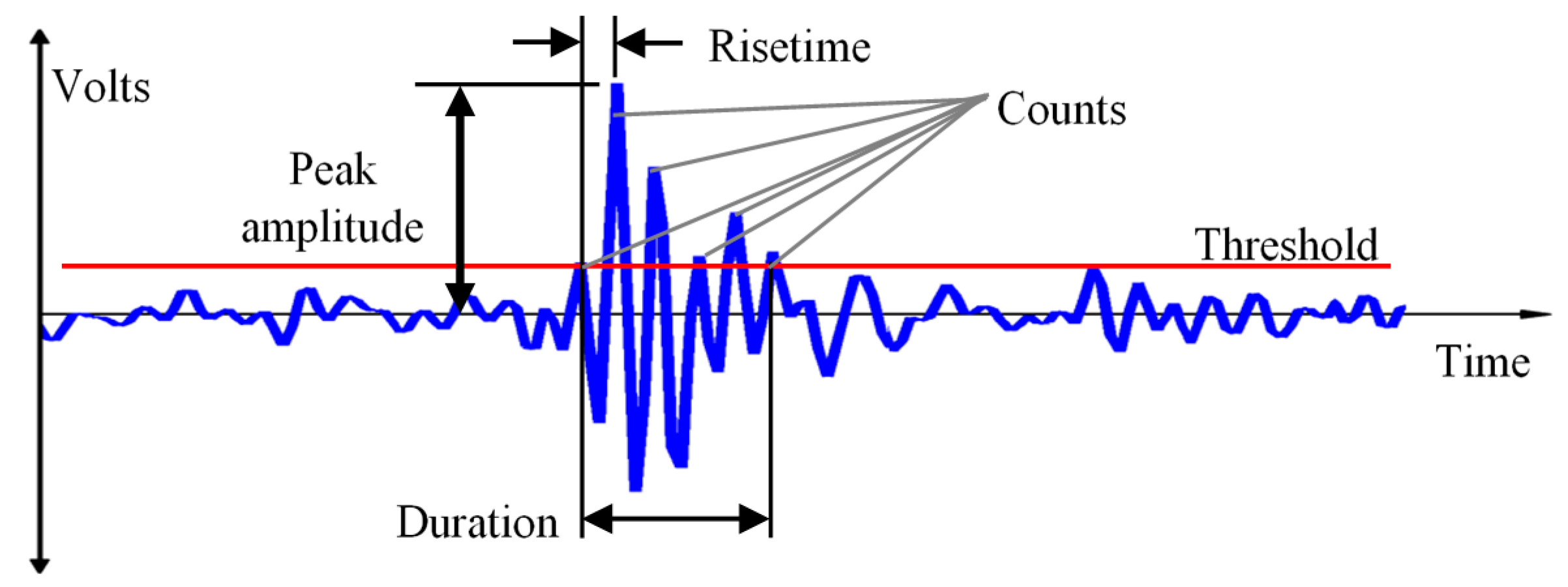
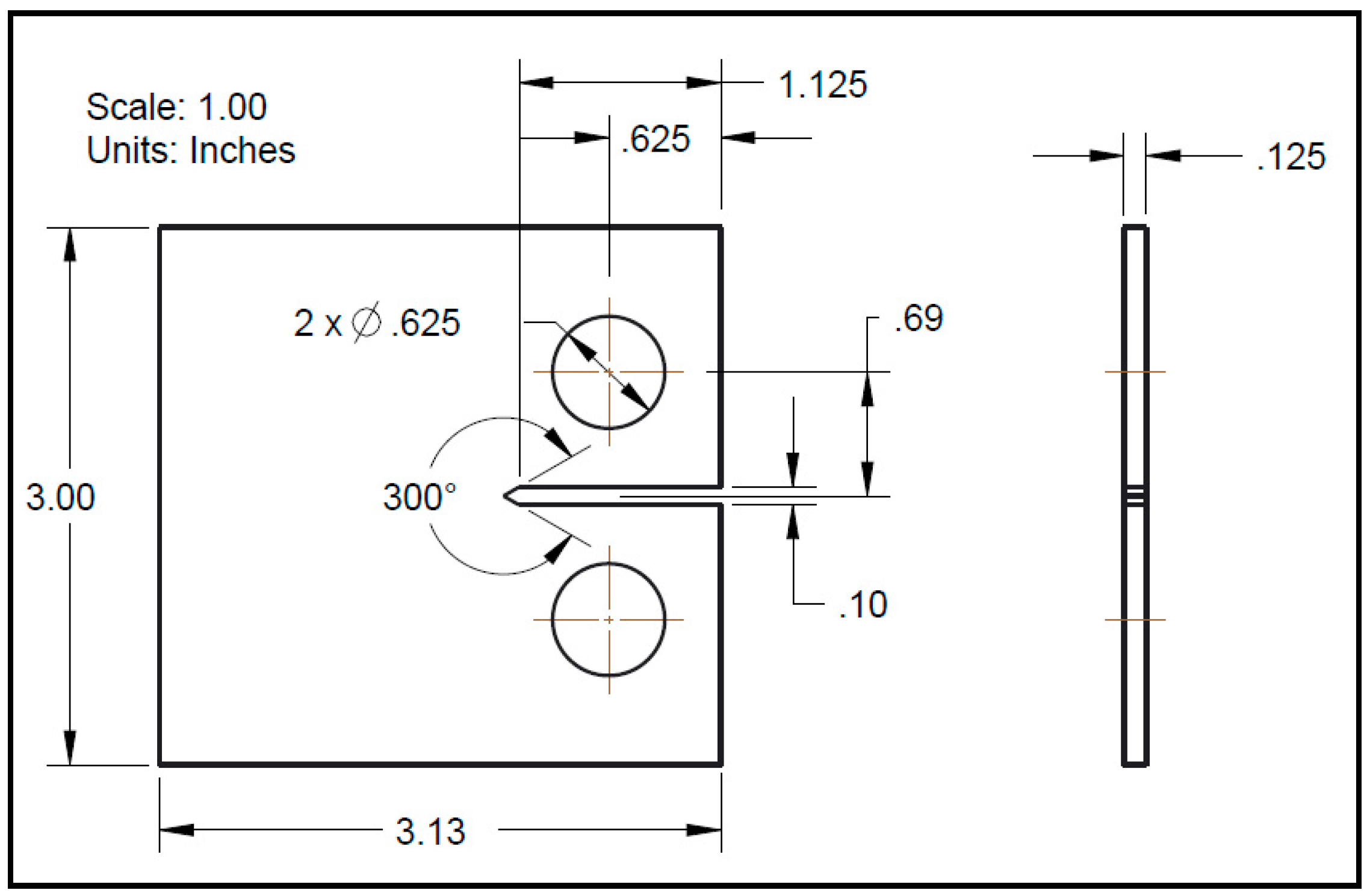
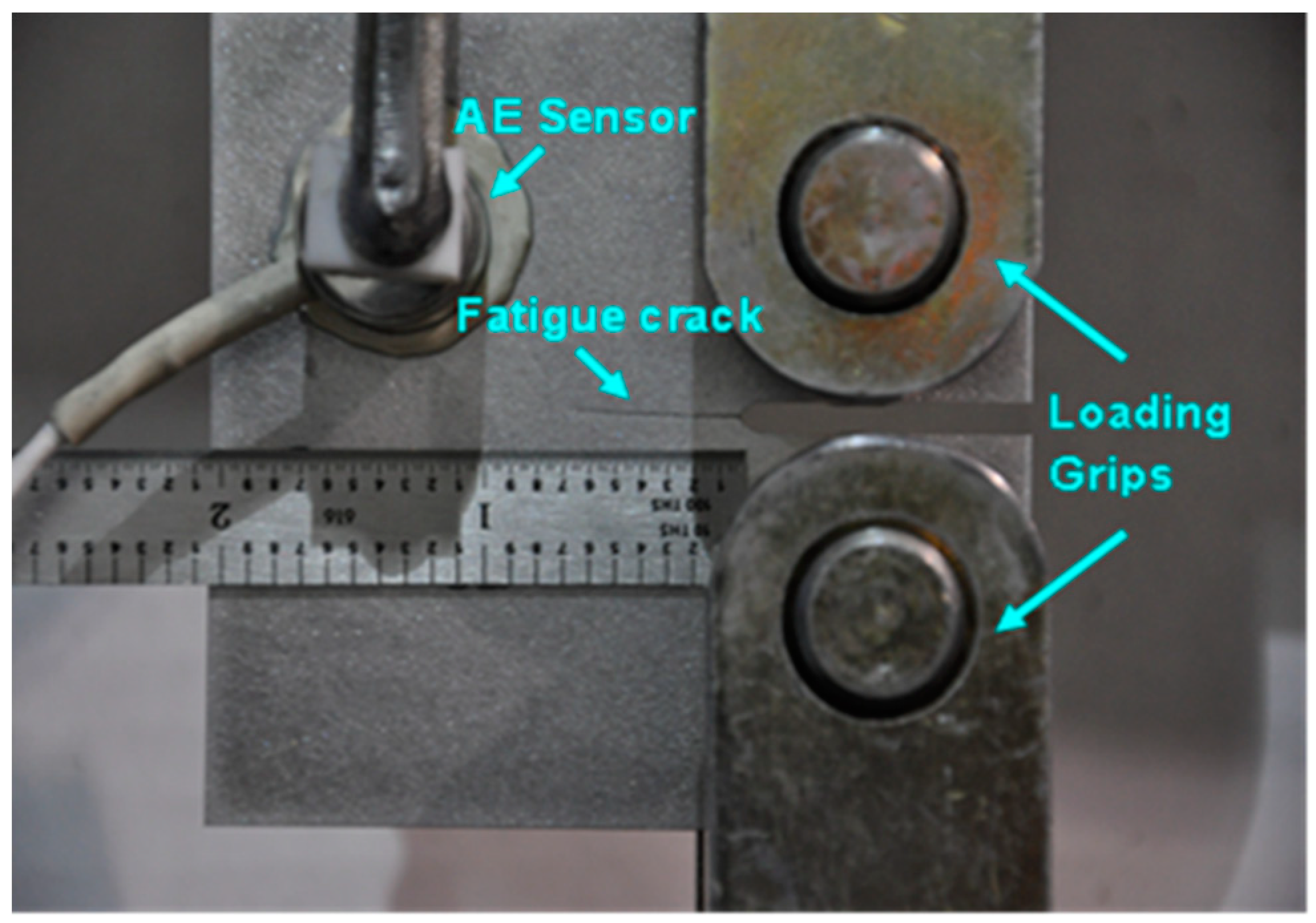
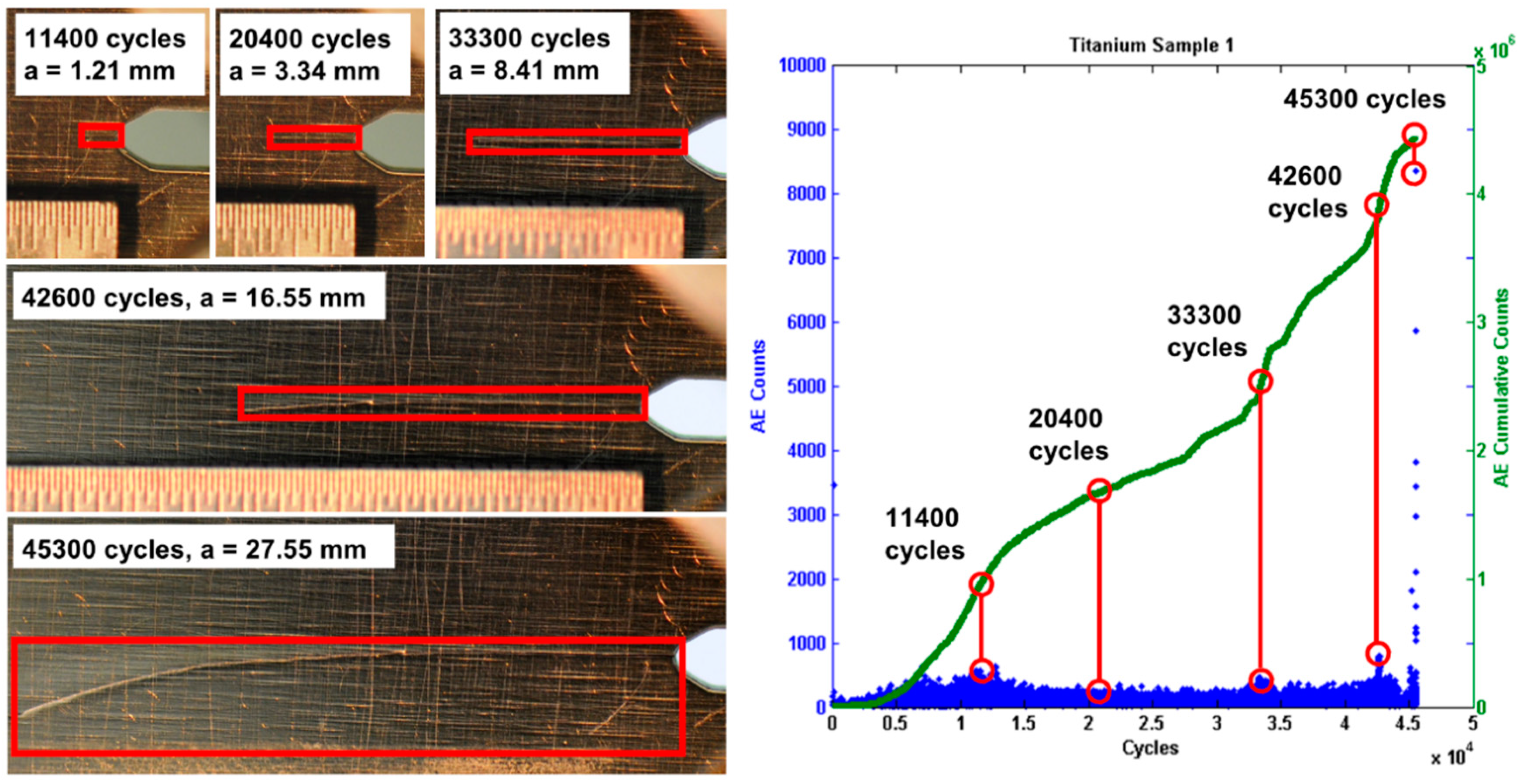


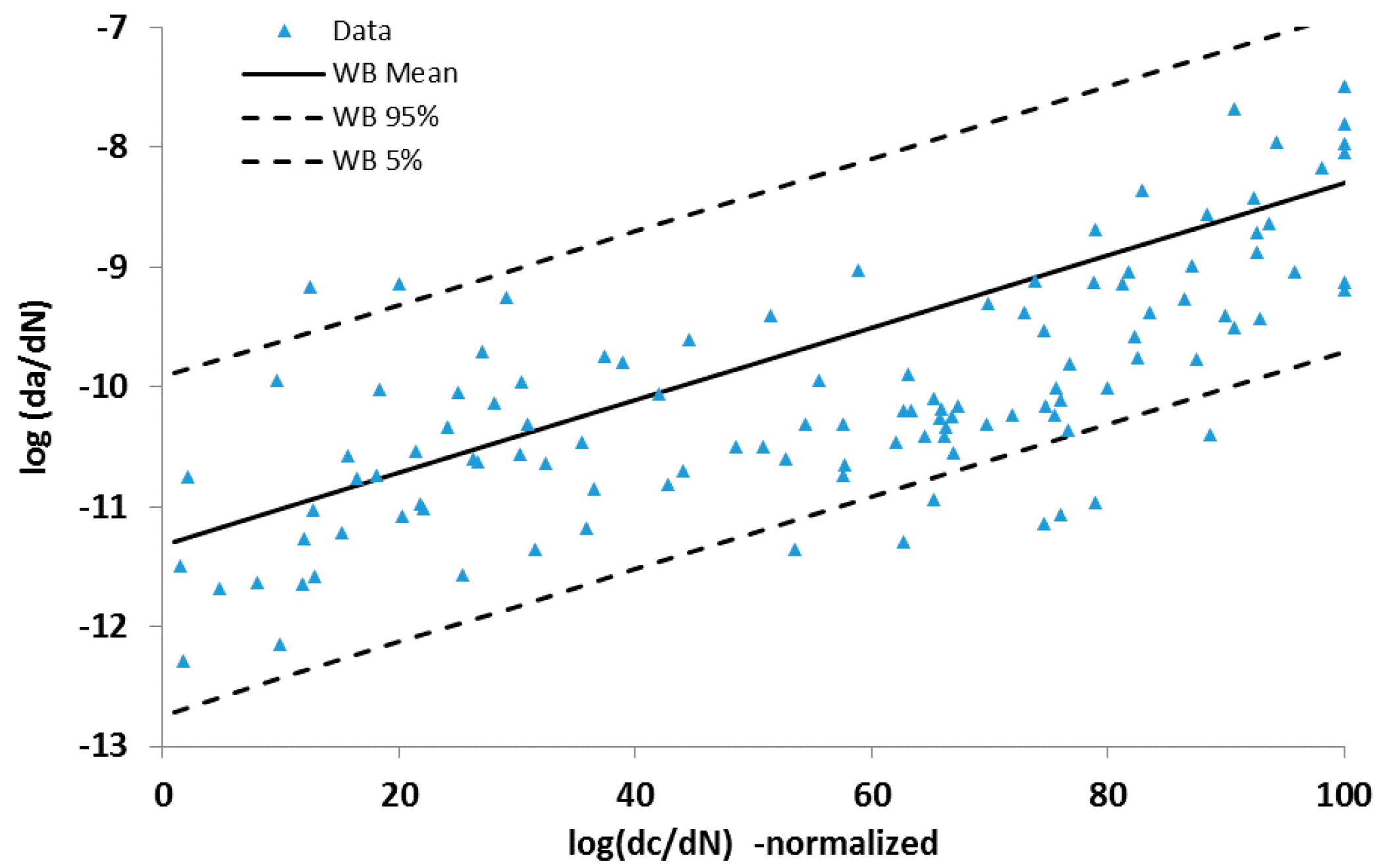
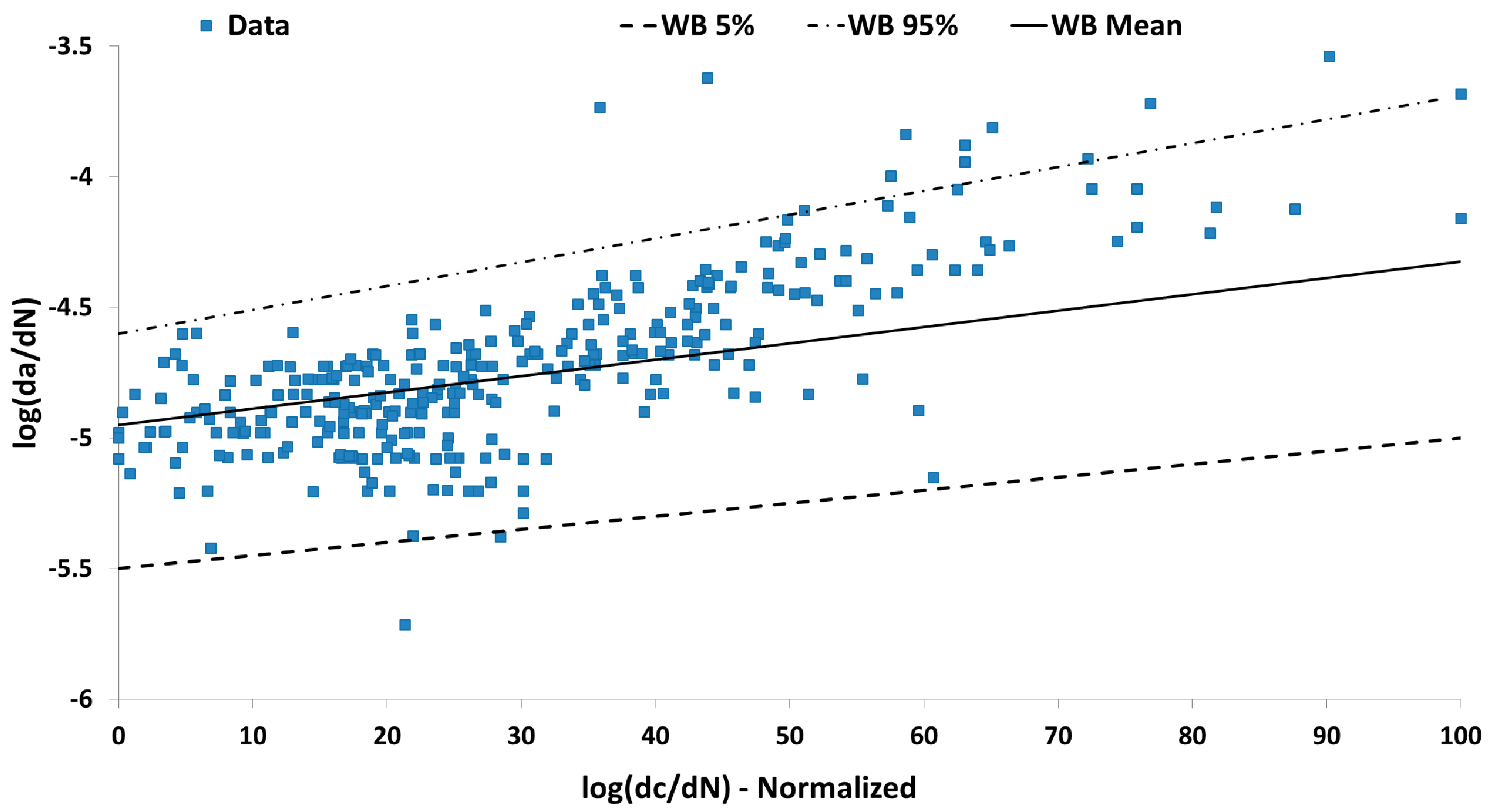
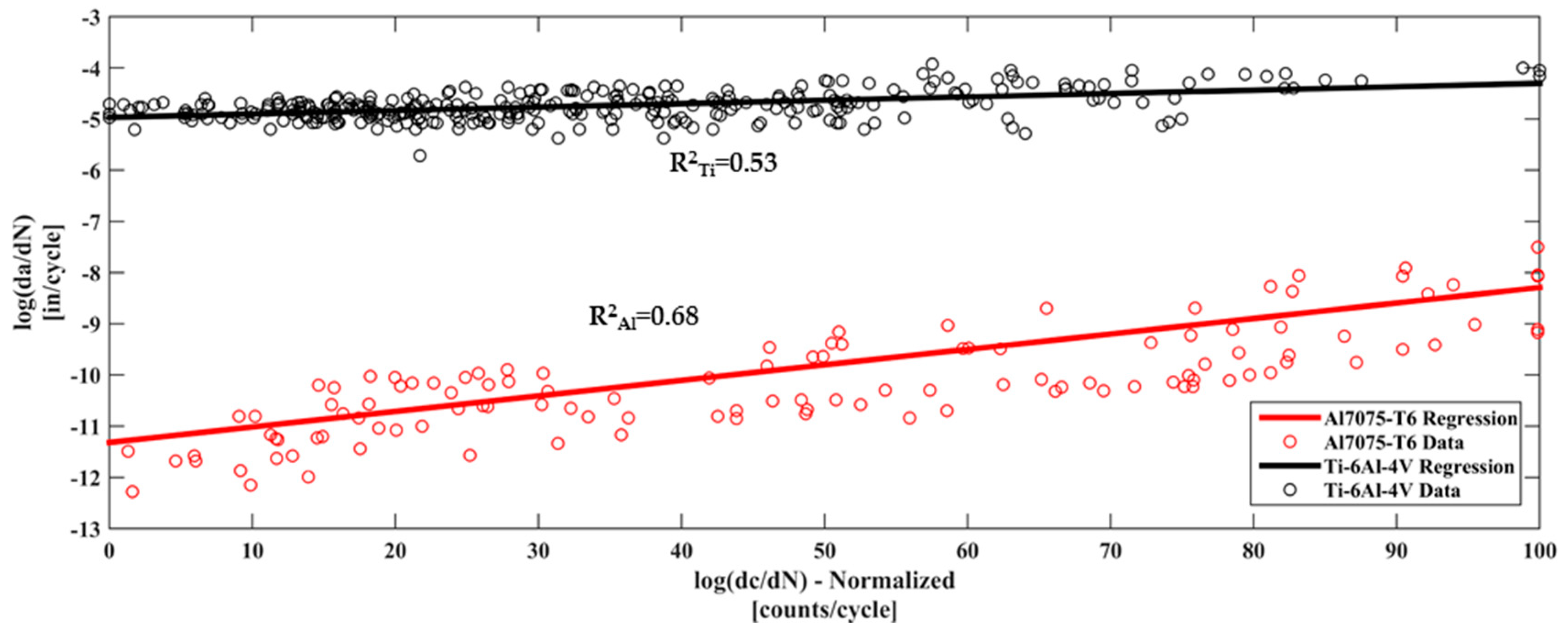

| Test Reference | Material | Loading Frequency (Hz) | Loading Ratio | Maximum Force (lbf) | Maximum Force (kN) |
|---|---|---|---|---|---|
| CT1 | Al7075-T6 | 10 | 0.1 | 500 | 2.22 |
| CT2 | Al7075-T6 | 10 | 0.1 | 500 | 2.22 |
| CT3 | Al7075-T6 | 10 | 0.3 | 500 | 2.22 |
| CT4 | Al7075-T6 | 10 | 0.3 | 500 | 2.22 |
| CT5 | Al7075-T6 | 10 | 0.5 | 500 | 2.22 |
| CT6 | Al7075-T6 | 10 | 0.5 | 500 | 2.22 |
| CT7 | Al7075-T6 | 2 | 0.1 | 500 | 2.22 |
| CT8 | Al7075-T6 | 2 | 0.1 | 500 | 2.22 |
| CT9 | Al7075-T6 | 7 | 0.1 | 500 | 2.22 |
| CT10 | Al7075-T6 | 7 | 0.1 | 500 | 2.22 |
| CT11 | Al7075-T6 | 10 | 0.1 | 500 | 2.22 |
| CT12 | Al7075-T6 | 10 | 0.1 | 500 | 2.22 |
| CT13 | Ti-6Al-4V | 5 | 0.1 | 900 | 4 |
| CT14 | Ti-6Al-4V | 5 | 0.1 | 900 | 4 |
| CT15 | Ti-6Al-4V | 5 | 0.1 | 900 | 4 |
| Test | Frequency | R | α1 | α2 |
|---|---|---|---|---|
| CT1 | 10 | 0.1 | 0.03 | −11.46 |
| CT2 | 10 | 0.1 | 0.03 | −11.17 |
| CT3 | 10 | 0.3 | 0.03 | −11.09 |
| CT4 | 10 | 0.3 | 0.02 | −12.01 |
| CT5 | 10 | 0.5 | 0.03 | −11.97 |
| CT6 | 10 | 0.5 | 0.02 | −11.77 |
| CT7 | 2 | 0.1 | 0.02 | −10.88 |
| CT8 | 2 | 0.1 | 0.05 | −13.86 |
| CT9 | 7 | 0.1 | 0.02 | −10.86 |
| CT10 | 7 | 0.1 | 0.02 | −10.74 |
| CT11 | 10 | 0.1 | 0.04 | −12.91 |
| CT12 | 10 | 0.1 | 0.04 | −13.41 |
| Material | α1 | α2 | ε ~ N(με,s) | s ~ N(μs,σs) | ||
|---|---|---|---|---|---|---|
| µε | μs | σs | ||||
| Al7075-T6 | 0.03 | −11.319 | 0 | 0.86 | 0.057 | |
| Ti-6Al-4V | 0.006 | −4.971 | 0 | 0.24 | 0.010 | |
| Parameter | Mean | Standard Deviation | 2.5% | Median | 97.5% |
|---|---|---|---|---|---|
| bm | 0.009 | 0.011 | −0.013 | 0.009 | 0.031 |
| sm | 0.059 | 0.008 | 0.045 | 0.058 | 0.078 |
| Fm | 1.011 | 0.061 | 0.894 | 1.009 | 1.141 |
© 2018 by the authors. Licensee MDPI, Basel, Switzerland. This article is an open access article distributed under the terms and conditions of the Creative Commons Attribution (CC BY) license (http://creativecommons.org/licenses/by/4.0/).
Share and Cite
Keshtgar, A.; Sauerbrunn, C.M.; Modarres, M. Structural Reliability Prediction Using Acoustic Emission-Based Modeling of Fatigue Crack Growth. Appl. Sci. 2018, 8, 1225. https://doi.org/10.3390/app8081225
Keshtgar A, Sauerbrunn CM, Modarres M. Structural Reliability Prediction Using Acoustic Emission-Based Modeling of Fatigue Crack Growth. Applied Sciences. 2018; 8(8):1225. https://doi.org/10.3390/app8081225
Chicago/Turabian StyleKeshtgar, Azadeh, Christine M. Sauerbrunn, and Mohammad Modarres. 2018. "Structural Reliability Prediction Using Acoustic Emission-Based Modeling of Fatigue Crack Growth" Applied Sciences 8, no. 8: 1225. https://doi.org/10.3390/app8081225




